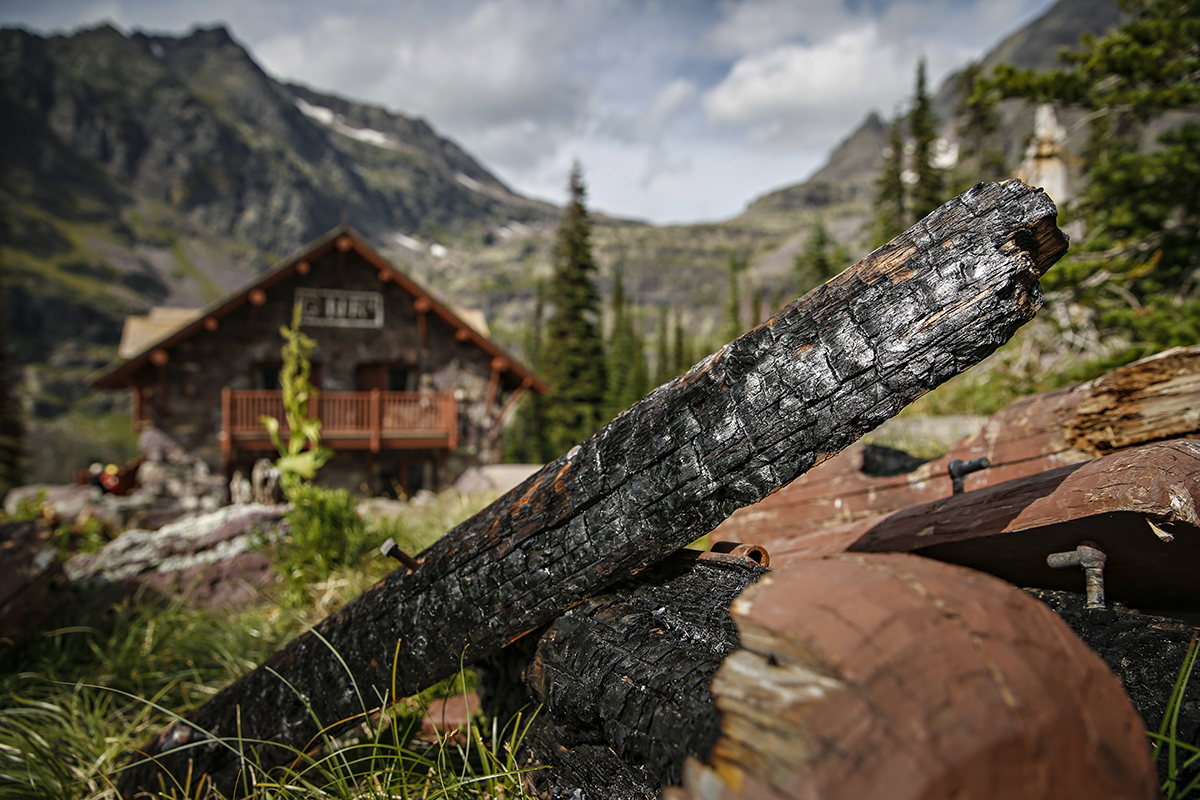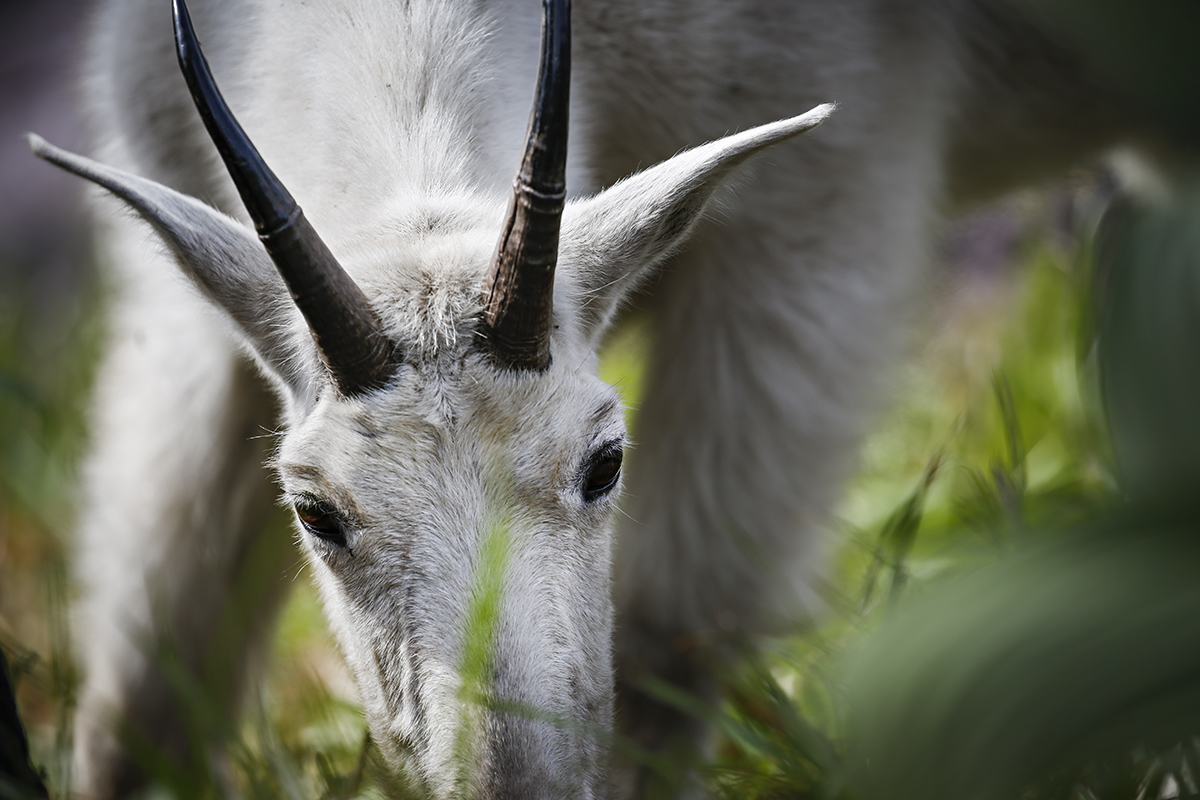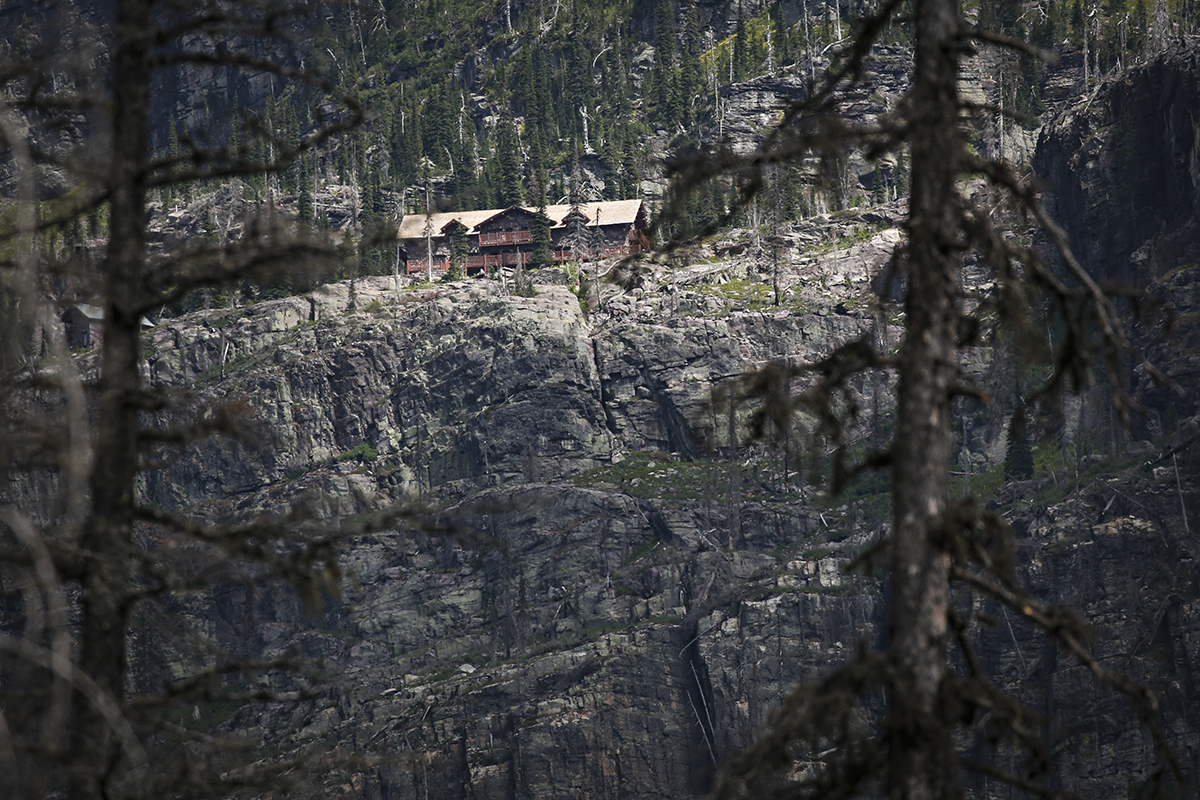
Chalet Stories
Two of Glacier National Park’s original eight chalets still exist, surviving harsh winters and summer blazes, and offer iconic destinations to hike and stay, if you can swing a reservation
A little more than three-and-a-half miles — and 1,700 vertical feet — into a hike from Lake McDonald Lodge, the trail to Gunsight Pass hooks sharply left. For a few hundred feet, the trees thin out into a strand of burnt trunks, offering the first glimpse of Sperry Chalet, perched high in the cirque at the end of the valley.
That view from the trail wasn’t possible four years ago.
“When I was a kid, you could just see more trees from down on the trail,” said Michael Warrington, the onsite manager for Sperry. “I remember my mom telling me that she remembered seeing buildings from the halfway point of the trail when she was 12. Now I can see it, but it’ll be another 20-year growth cycle before the trees block it off again.”
The Sprague Creek valley is full of similar fire scars, swaths of blackened trunks often next to copses of still-green conifers that survived the blaze that tore through the valley in 2017, burning nearly 17,000 acres and gutting the 104-year-old dormitory. The wounds left by the flames are easily visible from the deck of the chalet, but otherwise, with the hotel reopened, the fire seems a distant memory.
No fewer than two-dozen people were en route to the chalet the same weekday morning. Near the top of the trail, the biweekly pack string of mules was heading down, laden with laundry and canisters of garbage, having delivered groceries, linens and propane.
Along the cliffs, several parties of hikers sat on the rocks, eating lunch and taking in the view. On a clear day, Lake McDonald shimmers at the base of the valley, surrounded by mountains.
At the dormitory building, overnight guests were preparing for a day of hiking in the park, loading up premade sandwiches from the kitchen. It looked like any other day at Sperry over the decades.
“The biggest changes between the 80s and now is there’s a new bathroom building, and we don’t do our own laundry up here,” Warrington said. “Functionally we still do the same thing.”
Every day, the chalet’s team of nine staff cooks breakfast, lunch and dinner for onsite guests and provides a comfortable place to sleep in the backcountry of the park. Warrington said that his brother Kevin, the concessionaire who operates the chalet, hoped that last summer, the first for Sperry after a two-year, $12 million rebuild, would be a normal one.
“I don’t think there is such a thing,” Warrington said. “We had an avalanche take off the back deck of the hotel one year and cram rooms full of snow. We’ve had fire evacuations and smoke that made it difficult to operate. We’ve had droughts and rationed water from the reservoir, and [then] COVID.”
“I think normal is: We come up here, we serve three meals a day and put people up overnight,” he continued. “But the circumstances we do it in, is always a surprise.”

When Glacier Park was established in 1910, new visitor accommodations sprang up immediately. The Great Northern Railroad (GNR) built many of the of the lodges and chalets, allowing visitors to take the train to the park, journey on trail through the backcountry and stay at the accommodations spaced roughly a day’s horseback-ride apart.
As Glacier was considered the “Switzerland of America,” most of the buildings were constructed in a Swiss style that included exposed beams, widely projecting roofs, ornate decorative moldings and plenty of large windows and spacious balconies.
East Glacier’s Glacier Park Lodge, Lake McDonald Lodge on the shores of the eponymous lake, Many Glacier Hotel and the Prince of Wales Hotel across the international border in Waterton were all built in the first 15 years of the Park’s existence and remain popular among guests today.
The real gems of the Park however were in the backcountry chalets. The president of GNR, Louis W. Hill, oversaw the construction of nine backcountry chalets across the park, allowing visitors to trek hut-to-hut through the heart of the “American Alps,” a way to compete against Canadian and European resorts. The network of Swiss-style chalets was constructed between 1910 and 1915.
Only two chalets are still standing today, Sperry and Granite Park, the latter perched at 6,690 feet of elevation, high above the Loop along Going-to-the-Sun Road. These two locations differed from their sister buildings due to their construction from native stone, which better withstood Montana winters compared to the wooden structures of the other chalets.
In 1915, there were chalets at Cut Bank, Goat Haunt, Sun Point, Many Glacier, Gunsight Lake, Two Medicine and St. Mary. Many of the buildings could entertain 100 to 150 guests a night.
The Gunsight Lake chalet was the first to fall, destroyed by an avalanche in 1916. The Heaven’s Peak fire of 1936 burned down the Many Glacier chalets and following World War II, park officials did not consider most of the remaining buildings to be worthwhile to maintain and subsequently destroyed St. Mary, Cut Bank and Sun Point’s chalets. The Two Medicine chalet, where president Franklin D. Roosevelt once gave a fireside chat, was the last to come down in 1956, but a portion remains as a camp store.
In 1954, the Great Northern Railroad sold the chalets to the National Park Service for $1 each.
Around the same time, Kay and Ross Luding responded to an ad in the paper about the park service looking for someone to manage the chalets. Ross had been a member of the 10th Mountain Division in World War II, operating high in the Italian Alps. The infamous 10th Mountain Division trained in the Rocky Mountains skiing, mountain climbing and rappelling and used mule trains to get supplies to their camps.
Ross operated the chalets in the same way, modeling it on a nine-man infantry squad with trains of pack mules bringing supplies up the trail. Sperry operates with a similar model today. Now the Luding-Warrington family is on the third and fourth generation to operate the chalet with Kevin and Michael Warrington.
Michael Warrington says that if the world were his for making, he would advocate for reconstructing some of the old chalets, at Cut Bank, Two Medicine or Gunsight, to recreate the hut-to-hut hiking experience in the Park.
“I always say we’re the two smallest hotels in the world with the largest demand,” Michael said. “People would love more.”

Granite Park is a cluster of three buildings that can only be reached on foot; via the Loop trail (four miles, 2,300 feet of climb), the Highline trail (7.6 miles) or the Swiftcurrent Trail (7.5 miles, 2,285 feet of climb).
As is a common thread for Glacier’s chalets, the Granite Park chalet had its own close brush with wildfire, during the summer of 2003 when 26 separate blazes consumed more than 145,000 acres of the park.
The author Terry Tempest Williams wrote about staying at Granite Park that summer in her book “The Hour of Land: A Personal Topography of America’s National Parks,” and recently recounted the tale on a podcast by the New York Times.
“They got everyone out from the campgrounds — I think there were 24 of us — put us inside the chalet in a circle and said, the fire’s going to come. It’s going to roar over the chalet. The windows are going to shatter. You won’t he able to breathe. All the oxygen will be sucked out, and then it will go over, and hopefully we’ll be fine. They really thought we were going to die,” she recounted to the podcast host.
The group of guests, which numbered closer to 35, was considered dead by the Park Service in the immediate aftermath of the fire. The fire had come within 200 feet of the historic alpine building, split around the chalet, and blazed up Swiftcurrent pass. The windows remained intact, and no one was injured.

When the Sprague fire burned the Sperry Chalet down in 2017, there was an immediate reaction to save what was left of the history building. The Glacier National Park Conservancy was working with the park superintendent within 24 hours of the building’s demise. The Conservancy established a fund to stabilize the structure to ensure the surviving stone walls would survive the winter.
All three members of Montana’s congressional delegation voiced support for the rebuild, and then U.S. Secretary of the Interior Ryan Zinke, a native of nearby Whitefish, made it a national priority. Providing some extra media attention, the Capital Christmas Tree from 2017, an Engelmann Spruce harvested from the Kootenai National Forest to adorn the steps of the Capitol in D.C., was shipped back to Montana for use in the rebuild.
The two-year, $12 million reconstruction effort strove to recreate the chalet as closely as possible.
The rebuilt structure is virtually indistinguishable from the original. The masons who did the walls and interior work on the dormitory did so with such craftsmanship and detail that Warrington doubts anyone can tell it isn’t the original.
Anyone but him, that is.
“I’ve got this dissonance in my head every time I go in there,” he said. “It feels really familiar but it’s brand new — it’s got this new car feel to it. That’s a little odd to me.”
The first guests of the new chalet, Grace and Landon Gardner, of Missoula, arrived on July of last year without fanfare or a grand reopening celebration. Forty guests joined them for the first night in the revived chalet.
“We were just happy to be back in business,” Warrington said. “Everyone who has come up seems to be pretty happy as well.”
Now, it’s back to business as usual — or as usual as it is for a backcountry chalet in a national park.
Of all the guests Warrington interacts with, he especially enjoys meeting those visiting for the first time.
“I have no first memory of this place — I was 1 the first time I came up,” he said. “I live vicariously through people who are having their first experience. It just gets me every time.”